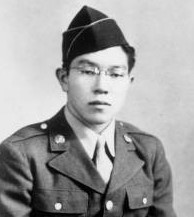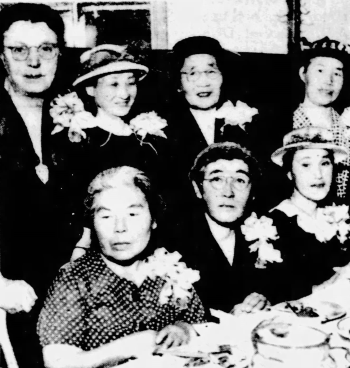
Masaru Nakagaki
Private
442nd Regimental Combat Team
3rd Battalion, K Company
Masaru Nakagaki was born on February 22, 1923, in Stockton, California, to Ushichiro and Tsuru (Asai) Nakagaki. He was the youngest of four children: sister Tomi and brothers Shigeru Oscar and Minoru. Ushichiro emigrated from the village of Tsubukuhon, Kurumi District, Fukuoka Prefecture, Japan. Tsuru emigrated from the village of Yasutake, Takeshima District, Fukuoka Prefecture, arriving in San Francisco on June 21, 1915, on the Korea Maru. Ushitiro worked as a farm laborer in the San Joaquin Valley, and by 1918 was farming on Wright Tract #3 near Woodland.
Ushichiro Nakagaki died in 1925 and was buried in the Masonic Lawn Cemetery in Sacramento. On October 13 in Stockton, his widow Tsuru applied for a marriage license with Mitsutaro Naka of Stockton, also from Fukuoka Prefecture.
In 1940, the family was living on a farm on Cache Creek Road, near Knights Landing in Yolo County and worked on the Robinson farm.
In May 1942, the family was evacuated to the Merced WCCA Assembly Center, located on the Merced County Fairgrounds about 125 miles from Woodland. They lived in Unit I-1-29.
A month later, Masaru registered for the draft on June 30, 1942, at Local Board No. 23, in Yolo County, California. The Merced WCCA Assembly Center was listed as his point of contact. He was 5’3” tall and weighed 135 pounds. His home address was given as Route 2, Box 131, Yolo County.
On September 3, 1942, Masaru and his family were incarcerated at the Amache WRA Relocation Camp, located near Granada, southeastern Colorado, where they lived in Unit 8E–1E. At the time, he had completed three years of high school, had worked on a vegetable farm, and was listed as having potential as a general unskilled woodworker. His sister Tomi Nakatsu and her husband were incarcerated at Rohwer WRA Camp in Arkansas.
Masaru enlisted in the U.S. Army from Amache on June 15, 1944. He was released from Amache on July 27 to Fort Logan, Denver, Colorado, where he was inducted into service on July 31. His civilian occupation was listed as “Kitchen worker” and his residence was Prowers County (where Amache was located), Colorado. Nakagaki was then sent to Camp Blanding, southwest of Jacksonville, Florida, for 17 weeks of training at the Infantry Replacement Training Center (IRTC) located there.
Pvt. Nakagaki arrived in the Mediterranean Theater of Operations as a replacement in early to mid March, after the 442nd arrived in Pisa for service in the Po Valley Campaign. Once with the Combat Team, he was assigned to K Company, 2nd Platoon.
The Combat Team’s presence in Italy was a closely-kept secret. Their mission was to create a diversionary attack on the western anchor of the German’s Gothic Line, an elaborate system of fortifications hewn out of solid rock and reinforced with concrete. The center part of these fortifications that spanned the Italian peninsula from east to west had been pierced during the Fifth Army’s 1945 fall offensive, but no one had yet been able to pry the Germans loose from the western end. These positions provided interlocking fires, all-around protection, and excellent observation posts to the defenders. Beginning on April 3, the 442nd began its continuous push against the German Army and objectives began to fall: Hills “Ohio 1,” “Ohio 2,” and “Ohio 3,” Mt. Belvedere on April 6 by 2nd Battalion, Montignoso April 8 by 3rd Battalion, Mt. Brugiana on April 11 by 2nd Battalion, Carrara by 3rd Battalion on April 11, and Ortonovo by the 100th Battalion on April 15. The 442 turned what had been planned as a surprise diversionary attack into an all-out offensive. The advance came so quickly that supply units had a hard time keeping up.
The 442nd drove so hard that beginning on April 17, the Germans decided to destroy their fortifications and pull back to make a final stand at the important rail junction of Aulla. The last German defense before Aulla was Mt. Nebbione, directly to the south. The final drive of the 442nd began on April 19 and lasted until April 23, when the 3rd Battalion finally took Mt. Nebbione and Mt. Carbolo.
Private Masaru Nakagaki was killed in action in the attack on Mt. Grugola near Fosdinovo and Castelpoggio, just south of Mt. Nebbione on April 21, 1945, during this fierce battle. The hospital admission card indicates that he was hit in the head and chest and died as a battle casualty.
Private Masaru Nakagaki was interred at the U.S. Military Cemetery at Granaglione, Italy, Section C, Row 3, No. 315. His death was announced in the Fort Collins Coloradoan newspaper on May 25, 1945, as a battle casualty from Amache. He was survived by his mother, Mrs. Tsuru Naka, step-father Mitsutaro Naka, sister Mrs. Tomi Nakatsu, and two brothers, Shigeru and Minoru, still incarcerated at Amache and Rohwer until the fall of 1945.
For his military service, Private Nakagaki was awarded the Bronze Star Medal, Purple Heart Medal, European-African-Middle Eastern Campaign Medal with one bronze star, World War II Victory Medal, and Combat Infantryman Badge. He was awarded the Congressional Gold Medal on October 5, 2010, along with the other veterans of the 100th/442nd Regimental Combat Team. This is the highest Congressional Civilian Medal.
In 1948, the smaller wartime cemeteries were being closed and families were given the choice of having their loved one moved to one of the larger cemeteries that would remain, or returning home. As a result, Private Nakagaki was brought home. His remains were among the 146 war dead from California who arrived in New York Harbor on May 24, 1949, on the USAT John L. McCarley. Dockside services were held at 9:00 a.m. on the upper level of Pier 3 at the Brooklyn Army Base for the 2,554 soldiers whose flag-draped coffins were brought back on this ship from Italy and North Africa.
After Pvt. Nakagaki’s remains arrived in Sacramento, a wake was held at 8:00 p.m. in the Buddhist Church on July 8, 1949. His funeral was held on July 9 at the Buddhist Church at 2:00 p.m. Immediately afterward, he was buried in the Sacramento City Cemetery, Veterans Plot, Tier 4, Grave 44, in Sacramento. The services were directed jointly by Post No. 8985 of the Veterans of Foreign Wars (VFW) and the Veterans Affiliated Council. His mother, who was living on Route 2 in Woodland, had signed the application for his flat bronze tombstone on June 30, 1949. She requested a Buddhist emblem and for his name to be also in Japanese if possible.
On June 6, 1951, at a dinner held at the Wakano Ura Restaurant in Stockton, attended by about 300 people, eight local sons who lost their lives serving in the 442nd RCT during the war were honored. Their parents, including Pvt. Nakagaki’s mother, Mrs. Tsuru Naka, were special guests at this event, which was sponsored by the Florin and Sacramento Chapters of the Japanese American Citizens League (JACL) and Nisei Post No. 8985, VFW. Immediately afterwards, at a ceremony on stage at the Senator Theater, the seven mothers and one father of the fallen soldiers were presented a Gold Star, signifying their lost son. The ceremony was followed by the showing of the new film, Go For Broke, starring Van Johnson and several 442nd veterans. William Sakai, a veteran of K Company, was chairman of the theater event. Many dignitaries, including Lieutenant Governor Goodwin J. Knight, State Senator Earl D. Desmond, and Mayor Bert E. Geisreiter, were present and gave remarks. As each Gold Star was presented, the soldier’s story was read. The ceremony concluded with Taps.
Below: Gold Star Mothers, Mrs. Tsuru Naka is seated on the far left

Researched and written by the Sons & Daughters of the 442nd Regimental Combat Team in 2021.
